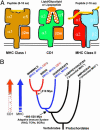Bird genes give new insights into the origins of lipid antigen presentation
- PMID: 15939875
- PMCID: PMC1150850
- DOI: 10.1073/pnas.0503313102
Bird genes give new insights into the origins of lipid antigen presentation
Figures

Comment on
-
Characterization of two avian MHC-like genes reveals an ancient origin of the CD1 family.Proc Natl Acad Sci U S A. 2005 Jun 14;102(24):8674-9. doi: 10.1073/pnas.0500105102. Epub 2005 Jun 6. Proc Natl Acad Sci U S A. 2005. PMID: 15939884 Free PMC article.
-
Two CD1 genes map to the chicken MHC, indicating that CD1 genes are ancient and likely to have been present in the primordial MHC.Proc Natl Acad Sci U S A. 2005 Jun 14;102(24):8668-73. doi: 10.1073/pnas.0409213102. Epub 2005 Jun 6. Proc Natl Acad Sci U S A. 2005. PMID: 15939887 Free PMC article.
References
Publication types
MeSH terms
Substances
LinkOut - more resources
Full Text Sources

